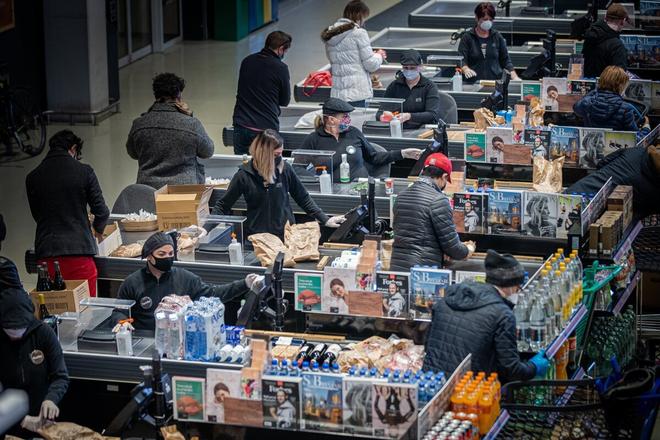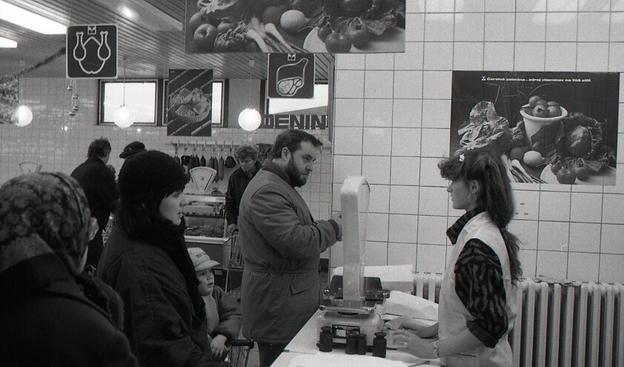The Velvet Revolution, which toppled the communist regime in present-day Slovakia in 1989, brought fundamental changes to the local economy, consumption, and shopping habits. Compared to the pre-revolution period, there are now more shopping opportunities, and people need to work fewer hours to earn the money required to purchase most goods.
“Unlike the period before 1989, characterised by shortages of goods and long queues in front of shops, today Slovaks have many more options for where and how to shop,” writes Eva Sadovská, an analyst at Wood & Company, in her analysis.
According to data from the Statistics Office, the sales area of shops has quadrupled since 1993, reaching the current 4.07 million square metres. The increased accessibility and elimination of product shortages are attributed, according to the analyst, to the arrival of foreign chains and the development of shopping malls, where shopping has expanded beyond goods to include experiences such as dining, culture, and entertainment.
Less time worked for grocery shopping, much more for housing
Today, on average, Slovaks need to work shorter hours to buy many groceries. This despite the fact that the previous two years have seen a sharp rise in the price of of food. This is especially true for meat products, eggs, as well as chocolate and sugar. However, to buy bread today, they have to work twice as long as they used to. Clothes and shoes are more affordable today, too. While the buying pumps cost a woman in 1989 almost two days of work, today it less than one full working day.
Goods | 1989 (beginning of the year) | 2024 (Q1-3) |
|---|---|---|
Dark bread (1 kg) | 2.80 (9 min.) | 2.50 (18 min.) |
Pork cutlet (1kg) | 46.00 (2 hours 35 min.) | 5.25 (37 min.) |
Chicken (1 kg) | 30.00 (1 hr. 41 min.) | 2.65 (19 min.) |
Durable salami (1 kg) | 60.00 (3 h 22 min) | 10.96 (1 h 18 min) |
Semi-skimmed milk (1 l) | 2.00 (7 min.) | 0.65 (5 min.) |
Eidam cheese (1 kg) | 23.00 (1 hr 17 min) | 8.56 (1 hr 1 min) |
Fresh hen's eggs (10 pcs) | 13.00 (44 min.) | 2.11 (15 min.) |
Apples (1 kg) | 6.00 (20 min.) | 1.25 (9 min.) |
Potatoes (1 kg) | 1.60 (5 min.) | 1.06 (7,5 min.) |
Crystal sugar (1 kg) | 7.30 (25 min.) | 1.03 (7 min.) |
Milk chocolate (100 g) | 11.00 (37 min.) | 1.21 (9 min.) |
Men's shirt | 131 (7 hrs) | 33.3 (4 hrs) |
Women's leather walking shoes - pumps | 270 (15 hrs) | 56.6 (7 hrs) |
Children's walking shoes | 115 (6 hours) | 33.8 (4 hours) |
Television (colour TV in 1989, LCD in 2024) | 13,000 (4 months) | |
Car (Favorit in 1989, Fabia in 2024) | 84,600 (27 months) | 16,850 (11 months) |
Car petrol 95 octane (1 l) | 9.00 (30 min.) | 1.60 (11 min.) |
Residential property price per 1 m2 2443 (36 days) | 650 (5 days) | 2,443 (36 days) |
Real wages only began to rise after 2007, and today Slovaks earn 35-40 percent more than they did in 1989. However, unemployment, which was almost nonexistent in the past, has experienced periods of double-digit rates. Despite the increase in unemployment due to the Covid-19 pandemic, which pushed the rate to 8 percent, it has since decreased to less than 5 percent.
When comparing average wages and prices, Slovaks today need to work less time to afford many products. For example, they spend significantly fewer working hours to obtain modern appliances and a car than they did before the revolution. On the other hand, housing is more expensive, requiring more time to purchase a home today than in 1989, when a square metre was more affordable. Trends such as shopping tourism and eco-conscious consumption have also emerged, with Slovaks increasingly focusing on sustainable shopping practices and waste reduction.
In the past, Czechoslovakia was a cash-based economy, with popular savings books. Today, Slovak citizens frequently use cashless payments, credit cards, and new investment options like mutual funds, real estate, and cryptocurrencies. However, Sadovská notes that despite this progress, Slovaks still hold a significant amount of money in deposit products.



